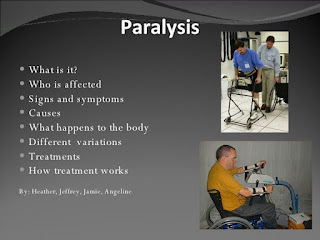Paralysis
A lack of motor function in one or more muscles is known as paralysis (also known as plegia). If there is sensory impairment as well as motor injury, paralysis can be followed by a loss of sensation (sensory loss) in the afflicted area. In the United States, around one in every 50 persons has been diagnosed with permanent or transitory paralysis. Palsy is paralysis that is accompanied by uncontrollable tremors.
The central nervous system (CNS), which comprises the brain and spinal cord, is divided into two divisions. The nerves outside of the CNS are included in the peripheral nervous system (PNS). The PNS's nerve cells, or neurons, fulfill a variety of purposes. Muscle movement is controlled by motor neurons, for example. Sensory neurons give information to the CNS, such as pressure, pain, and temperature. When nerve impulses are disrupted due to injury to the nerves, spinal cord, or brain, paralysis develops. The severity of paralysis is determined by the degree of muscular function lost. Partial paralysis, often known as paresis, results in substantial muscular weakening and mobility impairment. Paresis patients, on the other hand, maintain some control over the damaged muscles. When a person is completely paralyzed, he or she is unable to move the damaged bodily part.
Damage to the neurological system causes paralysis, which is the loss of voluntary muscular function in one or more regions of the body.
Duration: The duration of the paralysis relates to how long it lasts. Temporary paralysis can be caused by a variety of medical diseases, including sleep paralysis, stroke, and Bell's palsy. People can regain partial or entire control of their damaged muscles over time. Hyperkalemic or hypokalemic periodic paralysis are two more disorders that might temporarily cause the issue. They develop as a result of mutations in the CACNA1S or SCN4A genes. The instructions for generating proteins that transport sodium and calcium ions into and out of muscle cells are encoded in these genes. The movement and contraction of muscles are aided by the flow of ions within muscle cells. Ion flow disruptions can cause muscular weakness and paralysis on a regular basis. Serious head or neck traumas, as well as neuromuscular abnormalities, can result in lifelong paralysis.
Paralysis can take several forms, such as localized or generalized paralysis, or it might follow a certain pattern. The majority of paralysis induced by nerve injury (e.g., spinal cord injuries) is permanent; however, some kinds of periodic paralysis, such as sleep paralysis, are caused by other sources. Spina bifida is a congenital condition that can cause paralysis in neonates. Spina bifida is a condition in which one or more vertebrae fail to form vertebral arches, allowing the spinal cord to protrude from the remainder of the spine. In severe situations, this might result in the loss of spinal cord function below the level of the missing vertebral arches.
The loss of spinal cord function can result in lower-extremity paralysis. When spina bifida is left untreated, incidences of paralysis of the anal sphincter in babies have been documented. Even though it is life-threatening, many cases of spina bifida may be surgically rectified if caught within 72 hours of birth. The lower limbs show ascending paralysis before the higher limbs. Guillain–Barré syndrome (also known as Landry's ascending paralysis) is a neurological disorder. Ascending paralysis is different from descending paralysis, which occurs in diseases like botulism. To acquire prey, elude predators, or both, many animal species utilize paralyzing poisons. It was discovered that in inactivated muscles, the frequency of tiny potentials decreases in tandem with the decrease in postsynaptic potential and muscular contraction. This clearly reveals that venom from Microbracon (wasp genus) paralyzes the neuromuscular system by acting at a presynaptic location in invertebrates. At the same concentrations, Phyllanthus venom inhibits both the fast and slow neuromuscular systems. It reduces the frequency of the tiny potentials while having little effect on their magnitude [requires citation].
Invertebrates: In certain wasp species, the female paralyzes a prey item such as a grasshopper and deposits it in her nest to finish the reproductive cycle. The paralyzed insect (usually a bee species) of the species Philanthus gibbosus is covered in a thick covering of pollen. When the larvae hatch, the adult P. gibbous lays eggs in the paralyzed insect, which is consumed by the larvae.
Vertebrates: The tetrodotoxin produced by fish species such as Takifugu rubripes, the notoriously poisonous pufferfish of Japanese fugu, is a well-known example. This toxin prevents nerve cells from functioning properly by attaching to sodium channels. This toxin causes transient paralysis at non-lethal doses. This toxin is also found in a variety of different animals, including toads and nemerteans.
Damage to the neurological system, particularly the spinal cord, is the most common cause of paralysis. Stroke, nerve damage from trauma, poliomyelitis, cerebral palsy, peripheral neuropathy, Parkinson's disease, ALS, botulism, spina bifida, multiple sclerosis, and Guillain–Barré syndrome are all common causes. REM sleep causes temporary paralysis, and disruption of this system can cause bouts of waking paralysis. Curare, a drug that interferes with nerve function, can also cause paralysis. Pseudoparalysis (pseudo- means "false" in Greek) is an intentional limitation or inhibition of motion caused by pain, incoordination, orgasm, or any other reason other than real muscle paralysis. It might be a sign of congenital syphilis in a newborn. Pseudoparalysis is a typical component of mental diseases such as panic anxiety disorder, and it can be induced by high mental pressures. Chondrodysplastic dog breeds exhibit paralysis. These dogs have small legs, and their muzzles may be short as well. The substance in their intervertebral discs might calcify and become fragile. The disc may rupture in such instances, with disc debris entering the spinal canal or rupturing further laterally, pressing on spinal nerves. A mild rupture may just induce paresis, whereas a big rupture might result in circulation being cut off. If no evidence of pain can be seen, surgery to remove the disc material and alleviate pressure on the spinal cord should be undertaken within 24 hours of the incidence. The possibility of recovery decreases significantly after 24 hours since prolonged pressure causes the spinal cord tissue to degenerate and die. A fibrocartilaginous embolism is another kind of paralysis. A small particle of disc material breaks off and lodges itself in a spinal artery. When the artery's nerves are starved of blood, they die.
A limited part of the body, such as the face, hands, or feet, is affected by localized paralysis. Generalized paralysis affects a greater region of the body, involving several bodily parts. The following are examples of paralysis:
1. Monoplegia is a kind of paralysis that affects only one body part, such as one arm or leg.
2. Hemiplegia is a condition in which one arm and one leg on the same side of the body are paralyzed.
3. Paraplegia, often known as lower-body paralysis, affects both legs, as well as the hips and lower-abdominal organs.
4. Quadriplegia affects both the arms and legs, as well as the trunk muscles, internal organ functioning, or both. The most prevalent cause is spinal cord damage.
Lower motor neurons that stimulate skeletal muscle action are damaged by flaccid paralysis. Muscles weaken or degenerate throughout time. According to the Centers for Disease Control and Prevention (CDC)Trusted Source, flaccid paralysis is a frequent polio consequence. Inflammation of the spinal cord, commonly known as myelitis, and Guillain-Barré syndrome, a rare autoimmune condition in which the immune system assaults the PNS, are two more reasons. Muscular stiffness, involuntary spasms, and muscle weakness are all symptoms of spastic paralysis. Spinal cord injury, amyotrophic lateral sclerosis (ALS), stroke, or genetic spastic paraplegia can all cause this type of paralysis.
Other symptoms that might occur as a result of paralysis include:
1. Numbness or discomfort in the muscles that are affected.
2. muscle wasting.
3. Muscle loss can be seen (muscle atrophy).
4. Stiffness.
5. Involuntary twitches or spasms.
--Causes: The most prevalent causes of paralysis in the United States, according to the results of the 2013 U.S. paralysis Prevalence and Health Disparities SurveyTrusted Source, are:
1. Stroke.
2. Damage to the spinal cord.
3. Cerebral palsy is a condition that affects the brain.
4. Multiple sclerosis (MS) is a disease that affects people.
Damage to the neurological system, which can be caused by any of the health issues listed above, causes muscle weakness and paralysis. A healthy neural system transmits information from the brain to the rest of the body. The brain sends signals down the spinal cord and into peripheral nerves all around the body. The peripheral nerves control a variety of functions, including: Breathing and digestion, for example, are autonomic activities. Walking and chewing are two examples of voluntary muscular motions. Sensory functions such as pain, temperature, and pressure sensing are examples of sensory functions. Any damage to the nervous system can have a significant impact on a person's general health and quality of life.
Treatment: Permanent paralysis does not have a cure. The spinal cord is incapable of self-healing. Bell's palsy is a type of temporary paralysis that usually goes away without therapy over time. Physical, occupational, and speech therapy can help people with paralysis by providing exercises, adapted equipment, and assistive technologies.
Also, have a look at this video, which is a fantastic resource for learning more about paralysis. So, have a look at that video:
I hope you enjoyed reading this blog, and if you appreciate reading blogs, please let me know in the comments area below. Until then, stay smiling and have a wonderful day.
My past writings:
https://bustlingmindd.blogspot.com/2021/10/black-holes-and-secret.html









